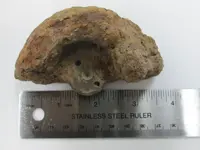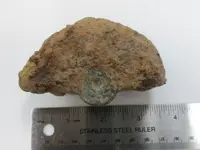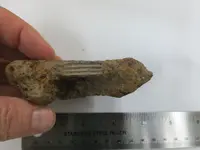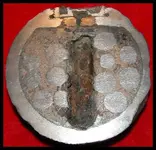Not from a Parrott artillery shell. It is definitely a fragment of the fuze-hole of a Bormann-fuzed explosive cannonball.
Here is more-specific ID info about your cannonball fragment:
1- Its Bormann fuze "support-plug" is made of brass, which about 98 or 99% of the time means it is a Confederate-made one. (The Yankees used an iron support-plug.)
2- By comparing your exploded cannonball fragment with the ruler in the photo, I can tell with certainty that the cannonball was 12-Pounder caliber... which means its unexploded body was 4.52-inches in diameter, for use in a 4.62" bore-diameter smoothbore cannon, such as a 12-pdr. Napoleon gun or a 12-pdr. Field Howitzer.
3- Your photo shows the broken-off "walls" of the shell's main body below the fuzehole area were about .5" thick (or slightly less). That means your frag is from a 12-Pounder Case-Shot shell... it contained antipersonnel balls in addition to its blackpowder bursting-charge.
Here's a photo of a sawed-in-half Confederate Bormann-fuzed 12-pounder caliber Case-Shot shell... the exact type your fragment is from. You can see the lead antipersonnel ("case-shot") balls inside it, and in particular, note the brass support-plug underneath the zinc-lead alloy Bormann timefuze. The vertical darkish area going down the center of the shell is where the gunpowder for exploding the shell was located.







